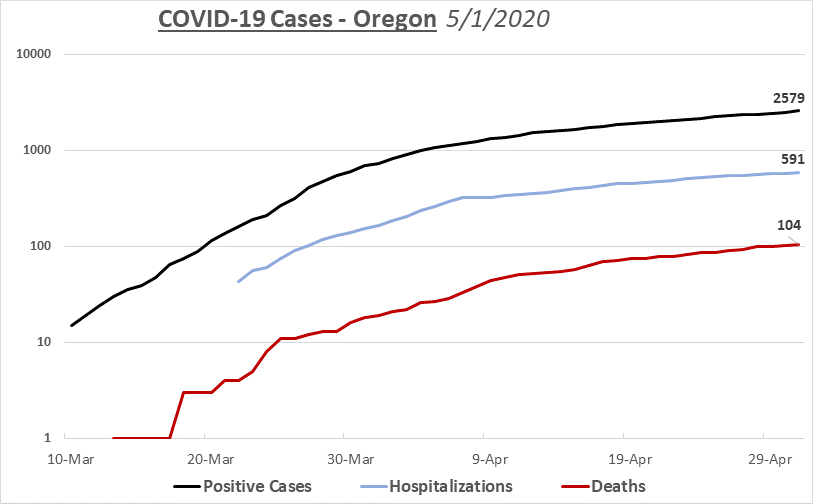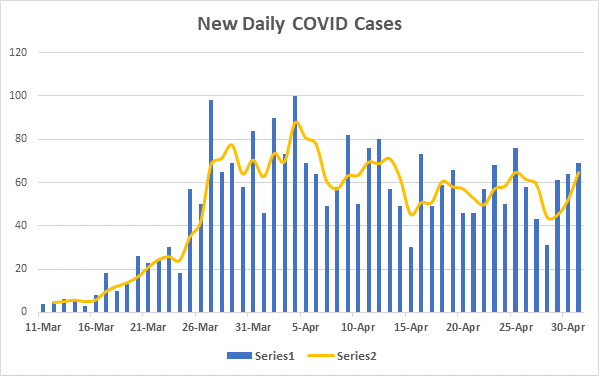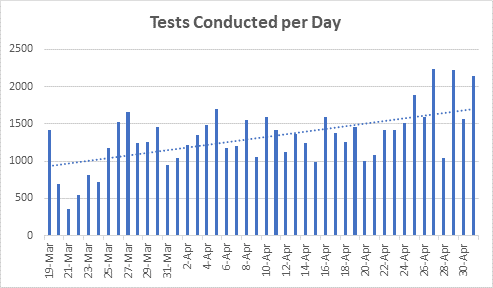|
May 1, 2020
Dear Neighbors and Friends:
Happy May Day! I hope that you and your loved ones are doing well, staying healthy, and looking out for your neighbors and friends.
In this newsletter you’ll get a detailed report on the Governor’s press briefing this morning, in which she talked about testing, the reopening process, and an exciting partnership with OHSU to monitor the spread of the virus around the state. You’ll also find the latest weekly testing report for the state.
In a briefing this afternoon, legislators learned that Oregon is currently #48 among the 50 states in terms of COVID infections by population, and our percentage of positive test results continues to decline as the number of tests increases. Very good to hear.
TODAY’S CORONAVIRUS AND CORONAVIRUS RESPONSE UPDATE

***Please notice that I’m using an exponential scale for the Y axis on this graph. Doing it this way allows me to keep all three in a single graph and allows for a more realistic sense of the upward curves of the three data points (positive cases, hospitalizations, and deaths).
-
Positive Cases: OHA has reported that 69 additional Oregonians tested positive for COVID-19 yesterday, putting the total at 2,579.
-
Total Tests: The total number of tests in Oregon now stands at 58,176. That’s a hefty increase of 2,144 tests.
-
Ratio: The percentage to-date of positive results is now at 4.4%. That remains much lower than the national average, which is inching down, now at 16.7%.
-
Deaths: I’m sorry to report that 1 additional Oregonian has died from the disease. The total number of deaths in Oregon is now 104.
-
Hospitalized: The number of Oregonians who have been hospitalized with symptoms, and who have also tested positive for the disease, is now at 591. This is an increase of 13 from yesterday.
-
Other Hospital Information:
- Patients Currently w COVID-19 Symptoms (who may or may not have received a positive test result yet): 208 (a decrease of 35 from yesterday). Of those, 105 have already received a positive test back.
- Available ICU Beds: 250 (a decrease of 43 from yesterday)
- Other Available Beds: 1,868 (a decrease of 181 from yesterday)
- ICU Patients w COVID-19 Symptoms (who may or may not have received a positive test result yet): 49 (16 fewer than yesterday)
- COVID-19 Patients Currently on Ventilators: 23 (5 fewer than yesterday).
- Available Ventilators: 797 (13 more than yesterday)
-
Today’s National Numbers:
-
PPE:
- In the last 24 hours the Emergency Coordination Center received another 34,000 face shields.
-
Testing Updates:
- We just received this week’s weekly testing report. In it you’ll find the latest numbers, our progress in getting to the reopening goal of 15,000 tests a week with declining percentages of positive results (we’re doing well on both counts), details about the new testing protocols, and remaining challenges.
- You may remember that FEMA gave us 15 Abbott rapid test machines a couple of weeks ago, but neglected to give us more than a handful of the testing cartridges to actually make them work. Well, good news at last. 90 boxes with 24 cartridges in each box (for a total of 2,160 rapid test cartridges) are on a plane en route to Oregon as I write this. That will allow the remaining 12 machines to be deployed around the state according to criteria and priority order established by the Governor’s medical advisors. The more capacity we have for rapid testing, the easier it will be to trace and track infections.
- FEMA has also just told us that they will soon fulfill their goal of providing enough standard testing materials (swabs and chemical reagents) to allow each state to test 2% of their population. (2% of Oregon’s population is around 86,000). Let’s hope they’re true to their word.
-
Other Quick Updates:
- I’ve heard from several constituents interested in becoming part of the new team of contact tracers who will be working for state and local public health. I’ve asked the agencies how people can apply. The answer is that the agencies are not yet ready for broad hiring—right now they’re using people redeployed from other areas of public health to increase their capacity. I’ll let you know when I do hear that they’re ready to bring in new people. In the meantime, I’ve been asked to spread the word that Multnomah County IS hiring staff for their new emergency shelters. They’re especially looking for people with backgrounds in behavioral health or experience working with the homeless community. You can get more information here.
- OSU is entering the second weekend of its community testing/tracing project called TRACE-COVID-19, which is similar to the OHSU study described below in testing and tracking a randomly-selected group of community members. For TRACE those community members are all in the Corvallis area. Results from the 960 samples taken during the first weekend of testing should be available next week. It takes approximately 7-10 days for the tests to be processed through OSU’s partner lab, Willamette Valley Toxicology. Results will be posted, without personal information, on OSU’s TRACE website. Participants will be notified of their personal results, and positive cases will be reported to the Benton County Health Department. You can read all about it on the website.
Additional Daily Graphs:



Governor Announces New Testing/Tracing/Isolating Program, Introduces “Key to Oregon” Program for Randomized Testing, and Gives Us a Date
The Governor held her press conference this morning and made several important announcements about testing, tracing, mapping, and studying COVID in Oregon, much of it within the context of plans for relaxing the state’s restrictions on various industries and activities. She was joined by the state epidemiologist and two leaders from OHSU, President Danny Jacobs and David Bangsberg, founding dean of the OHSU-PSU School of Public Health. Here are some of the key elements of her briefing:
Testing:
The Governor stressed the importance of ramped-up testing as a way to know that we are ready to reopen and as a way of monitoring the effect of reopening. She pointed to the newly expanded testing protocols that are now in place: testing should now be available for anyone showing symptoms, at no charge to them. It should be widely available for people working or living in congregate care settings, and she also pointed to those living in farm worker housing as necessary priorities.
She stressed that this testing capacity needs to be statewide, and it needs to be coordinated. She has met with the heads of the various hospital systems, and they have agreed on taking a statewide approach to testing, acting as a unified testing entity, with the large systems entering into partnerships with smaller rural providers.
She also stressed the need for randomized testing, i.e., including people who are not, or at least not yet, showing symptoms of COVID-19. This will be needed to understand the way that the virus is spreading and the extent of that spread, identifying any potential “hot spots” or areas of concern. Which leads us to:
The “Key to Oregon” Study:
The state is partnering with OHSU to conduct a big statewide study of COVID that is being called “Key to Oregon.” An initial $6 million is being deployed to generate, test, and track 100,000 volunteers around the state, including a representative sample of Oregon’s various ethnic, racial, socio-economic, and geographic communities over the next year. You can read all about it at the Key to Oregon website.
Participants will be selected at random and will receive an invitation to enroll, via U.S. mail, starting the week of May 11. Project staff will remain in contact with all 100,000 volunteers, will monitor their temperature and other symptoms every day over 12 months using state-of-the-art technology, such as Kinsa smart thermometers, to collect real-time data.
If volunteers show symptoms during that period, they will receive a home test kit. This will enable them to detect the virus at its earliest stage so they can better protect themselves, their family and the community. They will also be referred to the Oregon Health Authority for follow-up and appropriate action as needed. If they test positive, they will become part of the tracing/isolating process.
Among the 100,000, up to 10,000 randomly selected participants will also receive home testing kits to provide data about symptom-free infections, and to prevent wider spread in the community and state. That is, they will continue to be tested periodically even if they are not showing any overt symptoms.
Results will be shared regularly with OHA, which will be posting the aggregated information on its public website.
It’s an exciting project, one that will put us in the front ranks of those states trying to get on top of this disease. There are other states that are thinking about doing similar work, and the OHSU researchers will be communicating with them, so that the states can learn from one another and make good, science-based decisions going forward.
Testing/Tracing/Tracking/Isolating:
The Governor and Dr. Sidlinger, the state epidemiologist, also talked a little about plans for the new tracing process that is developing. It’s going to be a key piece of the reopening process going forward. As we learned from the new modeling scenarios that I mentioned yesterday, reopening will inevitably lead to more physical contact, which will lead to more infections. With an effective testing/tracing/isolating program, the number of those new infections can be reduced.
The Governor went over the elements of the plan that we’ve already been hearing about: 600 additional professional state and local public health disease trackers being hired in the coming months. Today she also stressed the importance of hiring individuals who have the linguistic and cultural skills to be able to work with a variety of communities, communicating with individuals who are going to be upset and scared about their possible exposure, explain to them about the true nature of the disease, explaining why they will need to be isolated for two weeks, and make sure that they get the support that they need while they’re doing that. It’s going to be crucial that we have the right people doing this work.
Reopening—Beginning with the Most Rural Regions:
The Governor has begun conversations with county commissioners and health professionals about potential reopening dates, beginning with those counties that have so far been infection-free. We’ll likely be seeing those counties move into Phase One as soon as May 15, followed gradually by others. She acknowledged that the reopening process will be slower than many would like, but promised that it would be based on the research and data. Physical distancing will need to continue, as will careful hygiene, and the wearing of masks in public places. There will be ongoing monitoring to make sure that the percentage of people testing positive and/or being hospitalized does not start to go up again.
More Upcoming Zoom Town Halls
As part of a continued effort to do coordinated outreach, I will again be partnering with Alissa Keny-Guyer and Barbara Smith Warner for constituent town halls using Zoom. Our first two went well, and we want to continue providing this avenue for dialogue and updates. Please mark your calendars for the next two Zoom town halls. I'll have a registration link available soon, so keep an eye on the newsletter. We will be holding town halls on May 7th and May 21st, both starting at 5pm. This time around, we'll be arranging for some special guest presenters -- you won't want to miss out.
Prohibition on Non-Emergency Veterinary Procedures Lifted
I mentioned yesterday that reopening guidance for veterinarians was forthcoming. It came out this afternoon. Here it is. Veterinary clinics that meet the requirements can open immediately for non-emergency procedures.
Again, here are the guidelines for the other medical sectors that were allowed to reopen today:
Want to See Past Newsletters?
If there was COVID-related information in a past newsletter that you want to go back to, but find you’ve deleted it, you can always go to my legislative website (www.senatordembrow.com), click on “News and Information,” and you’ll find them all there.
AND FINALLY,
Here again are some resources that you will find useful:
If the above links are not providing you with answers to your questions or directing you to the help that you need, please consider me and my office to be a resource. We’ll do our best to assist you or steer you in the right direction.
Best,

 Senator Michael Dembrow
District 23
email: Sen.MichaelDembrow@oregonlegislature.gov
web: www.senatordembrow.com
phone: 503-986-1723
mail: 900 Court St NE, S-407, Salem, OR, 97301
|